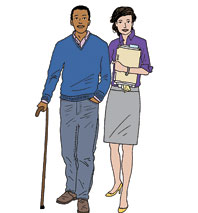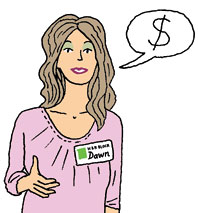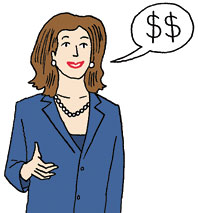
The annual tax quandary: Does a white-shoe accounting firm earn its fee by tripling your return, or are you better off going it alone? As filing time approaches, we shadowed one particularly complicated couple—Scott, a freelancer, and his wife, Zoe, a government-salary lawyer—down the three most common routes to see how each planner would handle things like medical expenses from Scott’s near-fatal accident (and subsequent five-digit compensation) and the couple’s goal to save for retirement. The firm wins—but, surprisingly, TurboTax comes pretty close.
THE SUBJECTS
Scott and Zoe Wilson*
(*not their real names)
Ages: 30
Her Occupation: Full-time government attorney.
Her 2007 income: $47,760.
His Occupation: Freelance photographer and artist. (Scott spent half of last year not working while he recovered from a hit-and-run accident.)
His 2007 income: $38,504: $15,502 from a variety of clients plus $23,002 ($4,252 for lost wages, $18,750 for pain and suffering) from New York’s Motor Vehicle Accident Indemnification Corporation.
Their Big Questions and Money Goals:
• How to report Scott’s accident money.
• How, after marrying midyear, to “merge our finances in the best possible way.”
• Preparing for a home purchase.
• Avoiding an audit.
• Saving for retirement.
Their Tax IQ:
Relatively high. The couple was diligent about documenting income and expenses in 2007, using Quicken software to stay on top of their finances.
THE SERVICES

The Cheap, Do-It-Yourself Time Sucker
TurboTax Online Home & Business 2007
turbotax.com
How it works: Choose from one of four software options, and start plugging in your data online, paying at any point before actually filing. Taxpayers are guided through a series of questions meant to mimic a live interview. Save time by assembling all the relevant paperwork (W2s, 1099s, expense records) beforehand.
The Wilsons’ experience: Working on his home-office computer, Scott initially moved quickly through the interview process, which helped him settle the question of whether to file jointly, as a couple, or separately (joint status won). Two hours in, a screen-freeze forced him to shut down and sign on again—a twenty-minute interruption spent fretting about whether answers had been saved. (They had.) Scott had to rely heavily on his 2006 return for minor issues, such as the appropriate business code to describe his work. More crucial: He couldn’t get any direction on reporting his accident-related income. Opting against the TurboTax “Live Tax Advice” service (questions answered by phone at $29.95 a pop), he made faulty judgment calls on two deductions and missed another altogether.
The pros: In addition to paying little or nothing in fees, you avoid sharing your intimate financial details with strangers.
The cons: Annoyingly chirpy windows pop up to plug other offerings from Intuit (the software’s manufacturer).
Cool features: A running tally of your refund—or tax bill—shows the impact of each entry; an Audit Risk Meter feature vets your return for IRS red flags.
Scott’s take: “It held my hand more than I thought a computer program could—but it also took twice as long as I expected.”
Time spent: 6.5 hours
Price tag: $114
Total refund: $2,466

The Dependable Chain
H&R Block
116 W. 72nd Street, nr. Columbus Ave.; 212-799-2134
How it works: Call for an appointment, or just walk into one of the city’s 197 branches and get assigned a “tax professional.” The pros’ experience levels vary—don’t expect a seasoned C.P.A. Unless your finances are particularly complicated, the process generally takes about an hour and you can usually walk out the door with a printed return, or e-file on the spot.
The Wilsons’ experience: Scott and Zoe were handed off to Penny Polatsch, one of several cubicle dwellers in a bright but lifeless office. A twenty-year Block veteran, Polatsch briefly quizzed the couple about their work, investments, and specific tax concerns before turning to the computer. Information-gathering went quickly; were it not for Scott’s accident-related income, the return would have been finished that day. But Polatsch wanted to call on the brain trust at Block’s Tax Institute—an internal resource for preparers stumped by a tax question—about whether Scott’s reimbursement for lost wages was taxable. Two days later, they reconvened for the happy news that it was not.
The pros: It’s the Starbucks of taxes: fast, predictable, and somewhere in your neighborhood. Pros will answer your tax-related queries year-round.
The cons: Privacy can be nil; on a busy day you’ll likely find yourself elbow-to-elbow with the couple in the next cubicle.
Cool features: Proprietary software vets returns for missteps and is continually updated as tax laws change. As with TurboTax, if you’re unhappy with either the final numbers or Block’s fee, you can bail at any time before actually filing.
Scott’s take: “After TurboTax, being able to talk things through was a huge relief. But I felt a bit rushed toward the end.”
Time spent: 2.5 hours
Price tag: $395
Total refund: $2,442

The Pricey, Fast, Confidence-Inspiring Firm
Amper, Politziner & Mattia Certified Public Accountants and Consultants
6 E. 43rd St., nr. Fifth Ave.; 212-682-1600
How it works: New-client calls are fielded by a C.P.A., who gently screens requests for tax-prep services. The minimum fee here is a hefty $750, and typical clients are often upper-tier execs or business owners with $1 million in income, although clients with complex tax returns or considerable future earning potential (like young lawyers) are also welcome. If you pass muster and are willing to fork over the bucks, you’re given a 30-page tax-preparation package to fill out before meeting with an accountant. Clients leave documents—and all that tedious computer work—with Amper and receive their return a few days later.
The Wilsons’ experience: Scott and Zoe met privately with Cristina Wolff, a principal in the company’s International Services Group, in a glass-walled conference room in Amper’s swanky midtown office. In addition to covering all the now-familiar ground of self-employment income and expense deductions, Wolff raised a few new issues. She suggested that Scott get a credit card dedicated exclusively to business expenses, and warned him that sales of photographs are subject to state tax, something Scott—who hadn’t sold any photos in 2007—will need to keep in mind for 2008. She also urged the couple, who are planing to have children, to get wills written, and quizzed them on their interest in saving for retirement, pushing them to open Roth accounts as a good way to start saving. She correctly split the $345 cost of last year’s tax preparation, deducting half as a personal expense and half on Scott’s business expenses. (Using TurboTax, Scott had deducted the full amount as a business expense—a move the IRS might frown upon.) Perhaps most important, Wolff zeroed in on Scott’s health insurance—covered through his wife’s employer at a payroll-deduction cost to the couple of $1,300 for the year. Wolff promised to check the tax status of Scott’s accident-related income, crunch the numbers, and e-mail a PDF of a completed return to review in a few days.
The PDF arrived two days later, showing by far the largest refund of the three methods. How did Wolff do it? By writing off the difference between what the Wilsons were deducting in health-insurance costs as a couple and what they should have been deducting for the self-employed Scott. It was a big find—one that dropped the couple’s adjusted gross income below $52,000, which, in turn, qualified their newly opened Roth accounts for a 10 percent federal tax credit that bumped their refund up another $400. All told, good accounting saved them $1,000—the exact amount Amper would be charging them.
The pros: Amper’s staffers exude competence, and the closed-door setting feels right when you’re sharing such private information.
The cons: At hourly billing rates of $100 to $400 (or more), the price tag will be hefty. And there’s no pay-if-you-like-us here; clients sign an agreement committing to Amper’s services and fees up front.
Cool features: Completed returns are reviewed by a senior-level C.P.A. for input errors and anomalies. Returning clients receive a tax organizer that shows prior-year expenses and income figures.
Scott’s take: “I’m psyched. Amper gave us financial advice for the future, and the new health-care deduction and credit they got us was a huge help—the extra money made up the price difference.”
Time spent: 2 hours
Price tag: $1,000
Total refund: $3,620